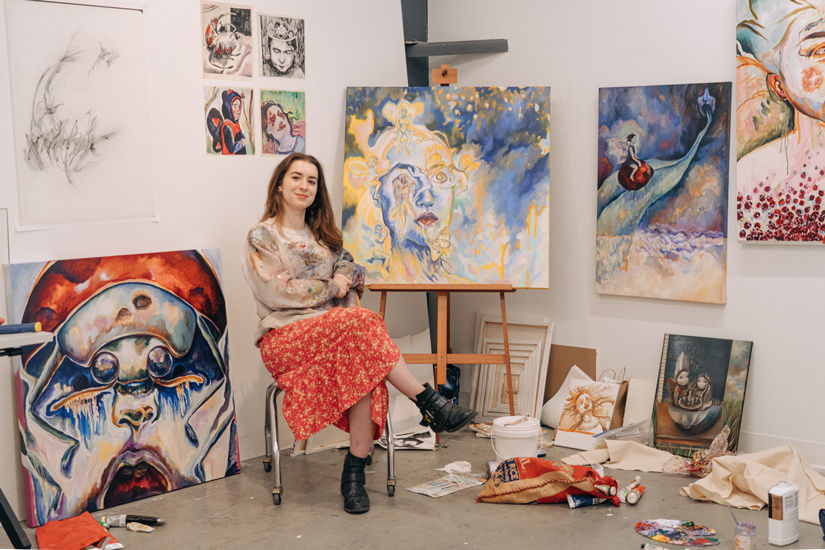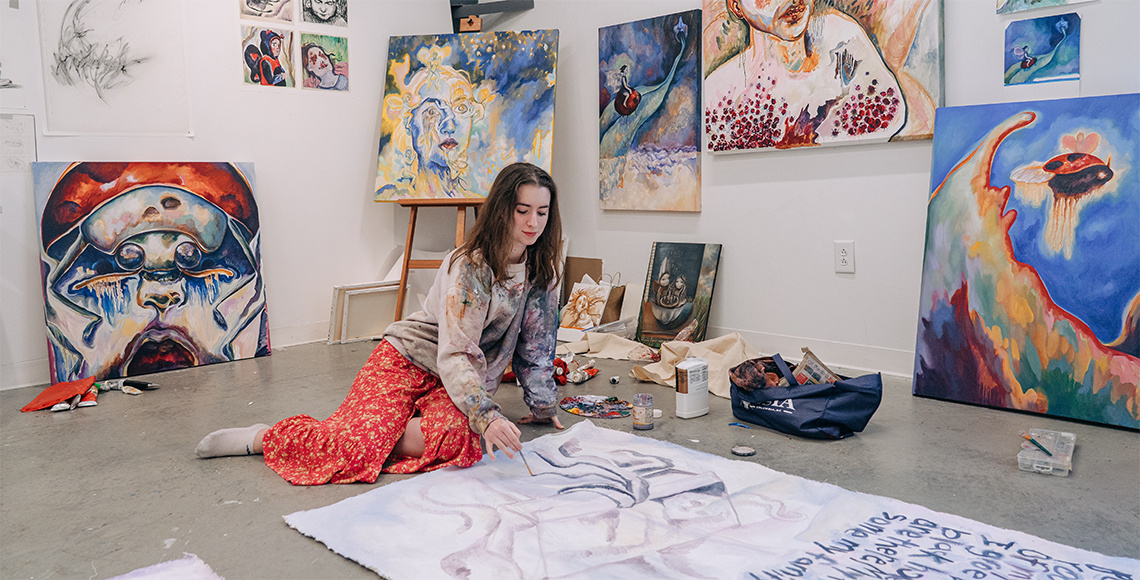When Abby Short was in elementary school, her teachers had to remind her not to monopolize the art station during play periods. But these admonishments could not dull her passion for artistic expression — the South Carolina Honors College sophomore from Charleston, South Carolina, has been creating art since she was able to hold a crayon. From crayons, she progressed to Prisma Color pencils, then added oil paints and gouache to her mediums of choice. For Short, art has been “a core pillar” of her life through which she explores themes such as “falling apart or crumbling under the analysis of some existential dread.”
From March 26 – 30, Short’s work will be on display at Columbia’s Stormwater Studios as part of the Stormwater Studios Collaborative Residency. This opportunity invites an art historian, an art educator, a graphic designer and School of Visual Art and Design undergraduates to work together for one year. This year’s participants are Short, Reece Bell (film and media studies and media arts), Joshua Kendrick-Johnson (studio art and photography), Crystal Smith (studio art and drawing), Emma Fricks (art education), Lili Norvell (art history) and Jon Glover (studio art and graphic design & illustration).
According to SVAD professor Kathleen Robbins, “This program emphasizes a strong collaborative element by placing artists and scholars in close proximity and supporting them in the development of a shared creative vision.”
I caught up with Short to learn more about her experience throughout the residency and to get a sneak peek of what will be on display at the exhibition, which runs March 26 – 30. Short’s responses have been lightly edited for length and clarity.
Q: What is the theme of this year’s exhibition at Stormwater Studios?
A: The fellow artist in residence and I decided on a loose theme: “yearning for something that doesn’t exist.” Over the following months, this led to us making work that explored memories from our pasts and analyzing those memories for their truthfulness. We often found a disconnect between our memories of our memories and the events themselves, creating a desire to return to something of our youths that didn’t quite happen. Before the show, when we needed a title that rolled off the tongue with more ease, we decided on the title, “And How Do You Remember It?” This title not only reflects the work of the artists but also engages the viewer in the question the title proposes.
Q: How does your art embody this theme?
A: I decided to take this theme and write a fictionalized story alongside my paintings. I took aspects of my childhood, starting from my legendary fourth birthday party, a time I often refer to as my happiest memory though I barely remember it, and twisting the memories that followed into a stilted fantasy. From attempting to ground this story in as close to verisimilitude as I could manage, I then have my ladybug Pillow Pet come alive and take this younger version of myself down the “Tongue of Time” to my present self. During the travel, my past self is confronted by memories she hasn’t yet experienced but is disarmed by the popping of her bubble of innocence as symbols like fairies, creatures I believed in religiously when I was younger, become more like fey. At the climax of the story, this version of me has to decide if she wants to go into the mouth at the end of the Tongue of Time and live in the present or jump off the side and live in the fantastical afterlife I wrote about when I was seven.
Q: What have you learned through this collaboration?
A: I have been collaborating with three other artists, a graphic designer and the art historian/curator. This experience has been extremely fruitful in teaching me when to give for the sake of the group and when to stand my ground when I need something for the exhibition to be done in a certain way. Because meeting with several college students at the same time on top of our busy schedules is nearly impossible, some things get lost in translation. It’s been meaningful for us all to work around this and find ways to communicate clearly to every member of the group.
Q: How have your artistic interests and abilities grown throughout this residency?
A: This residency has molded what I want my career to look like as an artist. Without this residency, I wouldn’t have come up with the story “Death of Ladybug Girl,” nor would I have the space or made the time to create such an in-depth body of work during the school year. This has opened my mind to how I can blend the mediums of paint and writing to make a mixed-media result, and I look forward to honing in on these interests. For my first group exhibition that I had a say in the theme/curation of the work, I feel so fortunate to have the other artists in residence around me so we can work out our uncertainties together, and it’s taught me to work more harmoniously with people and their creative passions. While I prefer to work in my own private spaces, I am so glad to have had this experience to make me try new things.
Q: If you could share one insight with those who visit the exhibition, what would you want to tell them?
A: I would invite them to study what piqued my interest as well. I found it so interesting that every artist had such a different approach to creating work around the theme. Some of it can be attributed to our different mediums, ranging from experimental film to charcoal drawing, but we also had different tones when making work about their pasts. People relate to their pasts in different ways. For instance, I am much more pessimistic when looking back, and some of the other artists were more nostalgic or even optimistic when making their work. Though our work is contrasting in that regard, they all come together with the theme “And How Do You Remember It?” since we all remember things differently.
As the residency draws to a close, Short is eager to continue exploring the relationship between visuals and text. She plans to continue working on graphic novels, blending the two genres.
“Being given this opportunity as Stormwater has let me experiment with those mediums,” she says, “and after this residency comes to a close, I look forward to polishing the work I’ve made for it and hopefully turning it into something really excellent.”

